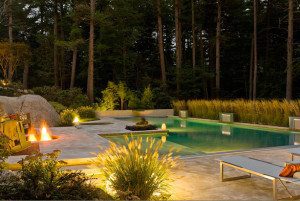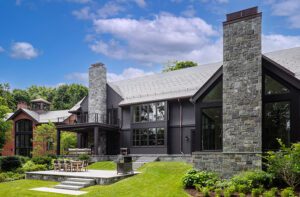A Little Bit Country
October 28, 2014
While many designers wouldn’t think twice about gutting a Beacon Hill townhouse from top to bottom or ripping apart a Nantucket whaling captain’s home to make way for the second dishwasher and warming drawers, houses in northern New England still garner a certain amount of respect when being updated for today’s families. In fact, sometimes they can even push a designer to tread where he or she has not so naturally gone before.
For interior designer Tiffany Eastman, it meant reining in her transitional tendencies and employing a more traditional look for the family who makes this 1786 Vermont house their weekend home. But don’t think for a second that traditional means stodgy for this not-yet-forty-year-old designer. Classic, yes, but fussy was a definite no-no for her and the clients alike.
To Eastman’s own surprise, the decades-old kitchen served as the inspiration for the design of the rest of the house. She changed not a single detail, and certainly not the green painted cabinetry that’s as eye-popping as the feathered peacocks that once roamed the yard under a previous owner. “Oh my goodness that kitchen,” says Eastman. “That’s what started it all. The second I saw it I knew it had to stay. It’s a cross between Kelly Green and Vermont Green—classic and timeless yet unexpected. There’s nothing about it that is run-of-the-mill, and it inspired the feeling, practicality, and timelessness of the rest of the decor.”
The owners, who have three young children, purchased the home furnished and lived with the existing palette of green and yellow for the first year. “They just aren’t my favorite colors,” confesses the wife. “After a while, I couldn’t resist having Tiffany put her spin on the house. I knew she could make the entire place become the home I didn’t even know was possible.”
Over the past two centuries there had been numerous changes: room additions, new kitchens, porches, and, at one point, a swimming pool built completely of marble. The owners shared with Eastman photo albums documenting the house back to the early 1900s.
“There was whimsy in the past,” says Eastman. “There were Regency influences, and the house was a bit Dorothy Draper for a few decades. I remember seeing an eagle over the front door that’s gone missing over the years. It inspired the bull’s-eye eagle mirror in the living room. I was on a hunt to bring that eagle back to the house.”
Private, yet so close to Manchester Center that you can grab a coffee and be home before it cools, the house is quintessential Vermont, from the snowmobile tracks family members make every winter to the 200-year-old trees that give them autumn apples. “We have three small kids, two dogs, and a cat, and they all travel with us,” says the wife. “We bring loads of friends here, and they all have kids. It really had to be a tough home, but I still needed it to be soft and have some glitz.”
“It’s an updated Vermont manor house,” says Eastman. “The accessories and artwork give a lot of decorative character to the house, and I tried to keep everything else really clean. Sometimes I tried to be comical with the elements, making a spoof on traditional. The wife likes things a little left of center.”
Eastman started in the living room, where she kept the colorful Persian rug and coffee table and reupholstered the sofa and wingback chairs, dressing them in Robert Allen fabric. She also kept a leather-topped desk centered at the window and accented the room with the eagle-topped mirror, antique trophies, and books. Dark gray walls and dark brown velvet draperies add to the clubby feel.
The mix of woodsy and fabulous begins in the hallway off the living room, where Eastman hung Nobilis wood-grain wallpaper and layered it with antique crystal sconces and a marble-topped console that holds a pair of stone horse heads. A nearby powder room features the existing old marble sink, but now the walls are clad in paper with a birch-tree motif that mimics the outdoor views.
The sunroom, which has floor-to-ceiling windows on both sides, takes a more feminine turn. Eastman warmed the marble floor with a cowhide rug, reupholstered the sofas, and added a new coffee table from Lillian August.
The family room seating area, which faces a massive hearth that was the home’s original cooking stove and heat source, is a favorite gathering spot. All the furnishings and fabrics, including the drapery, are neutral, allowing the accessories to set the tone. “There is a bit of a country house feel, with touches like the deer antlers, tree-branch wallpaper, and the bark-wrapped lamps,” says Eastman. “It’s all reminiscent of the surroundings.”
Similar accents find their way into the master bedroom, where a giant longhorn skull hangs above the bed against a cowhide-esque Donghia wallpaper.
“Skull and horn mixed with a crystal candelabra? That’s just me to put those two together,” says Eastman. Other contradictions, such as the gray-flannel headboard mixed with floral pillows and bed skirt, also just seem to work.
In the master bedroom’s dressing area, walls covered with a tromp l’oeil paper of gray-hued books surround a fringed ottoman. Downstairs in the dining room, another wall covering—this time by Osborne & Little featuring dozens of silhouettes—bridges the gap between whimsical and traditional. “It’s not too serious, but still traditional,” says Eastman. “This isn’t necessarily something you’d want to live with every day, but they’re not here every day.”
“I think my husband would live here year-
round,” says the wife. “Eventually, that could happen. Tiffany, in designing this house, has certainly made it an attractive idea, and I’ve already called
her with a few things I’d like to do additionally to the home. She’s going to have to get ready to go country again.” •
Share
![NEH-Logo_Black[1] NEH-Logo_Black[1]](https://b2915716.smushcdn.com/2915716/wp-content/uploads/2022/08/NEH-Logo_Black1-300x162.jpg?lossy=1&strip=1&webp=1)





















You must be logged in to post a comment.